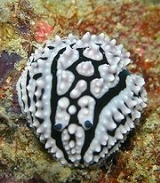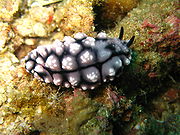
Phyllidiella pustulosa
Encyclopedia


Species
In biology, a species is one of the basic units of biological classification and a taxonomic rank. A species is often defined as a group of organisms capable of interbreeding and producing fertile offspring. While in many cases this definition is adequate, more precise or differing measures are...
of sea slug
Slug
Slug is a common name that is normally applied to any gastropod mollusc that lacks a shell, has a very reduced shell, or has a small internal shell...
, a dorid nudibranch
Nudibranch
A nudibranch is a member of what is now a taxonomic clade, and what was previously a suborder, of soft-bodied, marine gastropod mollusks which shed their shell after their larval stage. They are noted for their often extraordinary colors and striking forms...
, a shell-less marine
Marine (ocean)
Marine is an umbrella term. As an adjective it is usually applicable to things relating to the sea or ocean, such as marine biology, marine ecology and marine geology...
gastropod mollusk in the family Phyllidiidae
Phyllidiidae
Phyllidiidae is a family of sea slugs, dorid nudibranchs, marine gastropod mollusks in the superfamily Phyllidioidea.This family is within the clade Euctenidiacea .-Distribution:...
.
Distribution
This species is one of the most common nudibranchs throughout the tropical Indo-West Pacific.Description
Although this nudibranch changes appearance as it grows, three median clusters of (usually) pink tubercles remain the same, except that they are amalgamated in juveniles and separated in large animals. These tubercles can range in color from pink to green to white. The intensity of the pink coloration and green-grey tones may possibly be related to diet, and the length of time since last feeding. Other distinguishing features are the pale pink edge of the mantle, the broad, triangular, black tipped oral tentacles and the rhinophoral clavus possessing 22 to 26 lamellae (in specimens greater than 35 mm).Further reading
- Brunckhorst, D.J. (1993) The systematics and phylogeny of Phyllidiid Nudibranchs (Doridoidea). Records of the Australian Museum, Supplement 16: 1-107.
- Brunckhorst, D.J. 1993. The systematics and phylogeny of Phyllidiid Nudibranchs (Doridoidea). Records of the Australian Museum, Supplement 16: 1-107.
- Gosliner, T. Behrens, D.W. and Williams, G.C. 1996. Coral Reef Animals of the Indo-Pacific. Sea Challengers, Monterey, California.
- Litvaitis M.K. & Newman L.J., 2002. Color, Color Patterns and Mimicry.
- Newman, L.J.; Cannon, L.R.G.; Brunckhorst, D.J. 1994. A new flatworm (Platyhelminthes Polycladida) which mimics a Phyllidiid nudibranch (Mollusca, Nudibranchia). Zool. J. Linn. Soc. 110(1): 19-25. [publ. not seen by RFB]
- Newman, Leslie & Lester Cannon. 2003. Marine Flatworms: The World of Polyclads. vii + 112 pp. CSIRO Publishing.
- Rudman, W.B., 1998 (June 25). Mimicry - Phyllidiella, flatworms, Chromodoris [In] Sea Slug Forum.
- Rudman, W.B., 1999 (July 11). Comment on About Mimicry & flatworms by Christine. [Message in] Sea Slug Forum.
- Seifarth, W. 2004. Marine Flatworms of the World. http://www.rzuser.uni-heidelberg.de/~bu6/flatintr.htm]
External links
- Sea slug forum
- http://www.underwaterkwaj.com/nudi/porostomes/e044.htm

